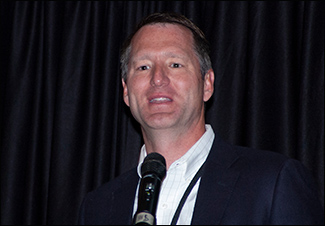Defining Efficient Red Meat Production
Target an optimum number of days on feed to improve feedyard efficiency.
by Troy Smith, field editor
LOVELAND, Colo., June 21, 2018 —Michael Genho would argue that the U.S. cattle-feeding industry is not as efficient as it thinks it is. Genho, who is director of feedyard business for Elanco Animal Health, said as much in comments delivered to the 2018 Beef Improvement Federation Convention hosted June 20-23 in Loveland, Colo. He suggested that cattle feeders need to look at efficiency differently.

Michael Genho, director of feedyard business for Elanco Animal Health.
Genho cited a business dictionary definition of economic efficiency as, "the comparison of what is actually produced or performed with what can be achieved with the same consumption of resources (money, time, labor, etc.)." That means what is actually produced must be compared with optimal production.
“I would submit that common feedyard efficiency metrics don’t do that,” said Genho, calling feed conversion ratio the most common efficiency measure. He explained that feed conversion does not account for costs or the value of what is produced.
“It fails to look at what’s optimal, not answering the question, ‘efficient compared to what?’” added Genho.
Noting the current practice of feeding cattle to very heavy market weights, Genho acknowledged the reason is to take advantage of marginal profit opportunity. But is it efficient? Genho cited Elanco feedyard data suggesting that it has a negative impact on feed required per pound of carcass weight gain — not live weight gain, but carcass weight gain. The data shows a 20-year trend toward worsening feed conversion among feedyard steers.
Genho believes that many cattle are reaching an optimal end point before managers realize it. Some cattle feed better than expected, hitting their end point earlier than projected. Therefore, those cattle are not managed effectively for efficiency.
Suggesting a goal of optimal days on feed, Genho said a better end-point metric is empty body fat (the percentage of body fat in a carcass) calculated from back fat, hot carcass weight, ribeye area and marbling score. Genho said cattle lot averages for empty body fat range from near 27% to 32%. However, there is “a boatload” of variation among animals within a lot.
“There is a ton of opportunity to improve feed efficiency, but we need to measure it in terms of what is optimal,” stated Genho. “We need to focus on optimal end point.”
Editor’s Note: The articles used within this site represent a mixture of copyrights. If you would like to reprint or repost an article, you must first request permission of Angus Media by contacting the editor at 816-383-5200; 3201 Frederick Ave., Saint Joseph, MO 64506. Angus Media claims copyright to this web site as presented. We welcome educational venues and cattlemen to link to this site as a service to their audience.


